QR codes. Breakthrough thanks to iPhone, iOS and a new,
intelligent function that may help Apple to sell more
Idea and Concept by Michael Koch
-->>> Download Full Concept as PDF
Tweet
Management Summary
Easy, fast, and
integrated.
An intelligent QR code scanner integrated in the iPhone camera.
Just unlock, point, and sell.
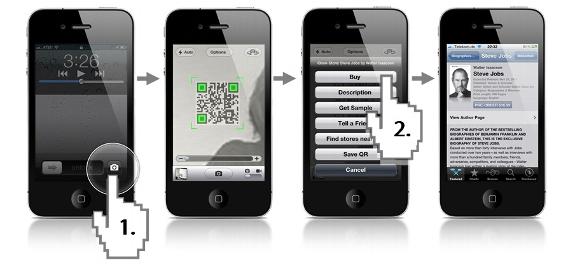
Direct access to the iPhone camera since the launch of iOS 5 paired with a new intelligently integrated QR code scanner within the camera application has finally brought the long-awaited breakthrough in user-friendliness by combining the physical and the virtual world with the related business models.
The presented solution sets standards for the widespread use of QR codes (easy, fast, and integrated). Apple would again offer advanced technology which can be intuitively used by everybody, generates new customer experiences and thereby promotes customer loyalty to the product. Further, it increases the distribution of strategic business models by means of integrated and enhanced product purchase transactions.
Just unlock, point, and sell.
The iPhone camera is by far the most widely used camera in the world*1. Its lead on its competitors is most likely to increase even further since the new iOS 5, which was introduced in last fall, has made the camera even more quickly for use thanks to direct access via the Lock screen. This small feature opens the door to further intuitive possibilities of usage.
Apart from the iPhone’s revolutionary user interface, the increasing proliferation of QR codes in our daily environment provides the basis for this concept. In 1994, Toyota developed these patterns of squares in black and white for the optimization of its logistics. Now, 18 years later, we find them in newspaper ads, on billboard posters, on plane tickets, in museums and on wine labels.
Basically, the success of distribution of these binary characters in our real world is owed to 2 factors: de facto value added and marketing utopia. The code's value added consists in bridging the gap between the physical and the virtual worlds. In combination with a smartphone including the appropriate app, a printed, standardized, and bug-tolerant QR code enables a direct decoding and further processing on the web (mobile tagging). QR codes thus represent an important step towards the simple and integral networking between the worlds. Whereas in the past website URLs were presented in newspaper advertisements of crossmedial campaigns in a cumbersome manner (which also was not very inviting for the prospective customer who had to retype it), nowadays small patterns of squares create directly-connected customer experiences thanks to a ‘secret code’, leading to increased sales, higher customer retention and more efficient processes. So far on the marketing utopia.
Sounds fantastic – however, it is not (yet) real.
Although the QR codes and smartphones have massively proliferated*2 and innumerable ‘apps’ for scanning QR codes exist, the usage rates and the related contact rates are very low*3. Accordingly, a current study*4 shows that 83% of young shoppers cannot handle QR codes.
What is it all about?
It is simple: The handling is too complicated, not yet integrated in the smartphone’s standard userinterface and does not offer an intelligent connected customer experience.
Nowadays, a prospective customer has to carry out at least 6 – partly troublesome and complicated – steps in order to scan a QR code and to do something worthwhile with the result at all. The current ’QR-Scan-Dilemma’ can be stated as follows:
Precondition
1. Find an appropriate QR code app, possibly buy, install and
understand it*4 (see Backup)
In the concrete case of application
2. Unlock smartphone
3. Find and start the specific QR code app
4. Wait for startscreen and for the specific app and camera to
warm up
5. Scan QR code
6. Decide how to further process the result
This explains why only the ‘early adopters’ have scanned the QR code up to now, why the vast majority of the prospective customers unfortunately do not use those valuable ‘codes’ and why the marketing utopia has ultimately failed.
What kind of solution could create a simple and intuitive customer experience and at the same time also support the business model of Apple and all advertisers?
Due to its market position (distribution/usage), the revolutionary user interfaces and the iPhone’s hardware features, Apple can help to ensure the QR codes breakthrough and thereby massively push its own business strategy.
The solution
The solution is to implement an intelligent integrated QR scanner function as a new feature of the iPhone camera as described below.
The proposed solution simplifies the handling from 6 to only 2 simple steps or clicks and reduces the time required for a scan by as much as 80%:
1.
Click on the new camera icon on the Lock
screen and scan a QR Code immediately
2.
Intelligent interpretation and simple decision
for direct integrated customer experience
This solution creates important preconditions for the broad use of QR codes (easy, fast, integrated) and Apple would again offer advanced technology which is intuitively usable for everybody. Furthermore, the solution is intelligent, safe, and will multiply the actual use of any QR application examples as well as the related business models for Apple (e.g. app, music and book sale).
Concept for transforming the user-interfaces into an intelligent, intuitive and integrated QR scanner solution in iOS
Case studies, screen flows & business cases
(1) Simplified camera access in iOS
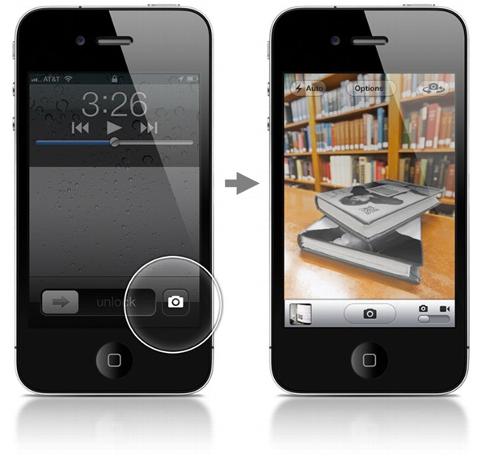
Camera icon on Lock screen enables direct access to camera shooting mode
Since iOS 5, an important prerequisite has been created. Now - after one click on home or on/off button - the camera is immediately ready even in its locked condition and thereby offers new possibilities of usage.
(2)
New function:
Supplementary SCAN option can be activated in the camera menu
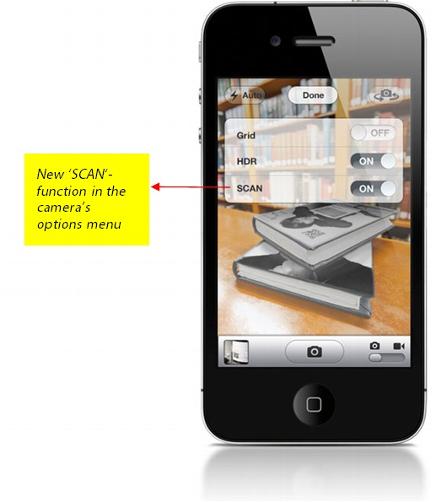
Via the ’options' menu a new ‘SCAN function’ can be activated. This option activates the integrated function for scanning QR codes, making it (permanently) available in the shooting mode.
(3)
New function:
Direct QR recognition in the camera shooting mode and integrated context menu
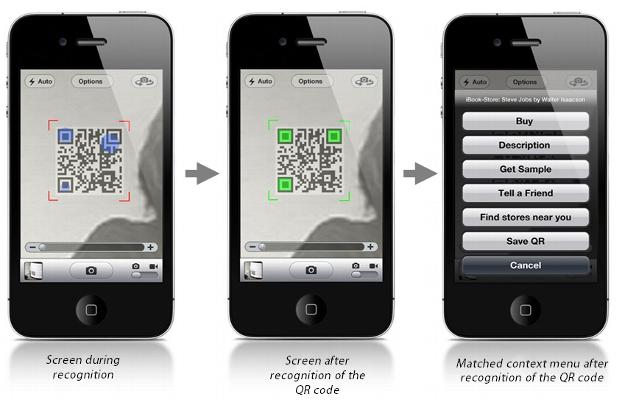
Integrated
and
active SCAN function in the camera shooting mode and seamlessly
integrated context menu.
Just unlock, point and use (QR code).
The ‘SCAN function’ is now available in the camera’s shooting mode. On the screen, thin red frame lines pop up to indicate the activated function.
During a scan (point camera on QR code), the search spots for the code’s recognition are displayed as further customer experience (frame lines still red / searching points animated and blue).
Upon entering the search grid, the QR code is automatically identified, the graphical drawing guides and the search spots change their color into green. The user does not have to press the shutter button. Just unlock, point, and use. After recognition, intelligent interpretation causes a context-sensitive menu to display.
Notes:
Other camera functions (shutter, zoom, focus, white
balance, HDR) can be used without any restrictions when
the scan function is activated, too. Only ‘Grid’ is
deactivated because of the scan function’s frame lines.
Optionally, a tone or a vibration can be activated in the
global adjustment menu as soon as the
code is identified.
Examples of usage
(4) New function: Intelligently integrated context menu after recognition of QR code
After recognizing a QR code, an intelligently integrated context-sensitive iPhone menu based on information provided by the scanned QR code is displayed depending on the code’s contents (e. g. link to iTunes, iBook store, App store, Safari URL).
Some selected application examples are listed below:
4.1 Context menu after QR code recognition with link to the iBooks- Store
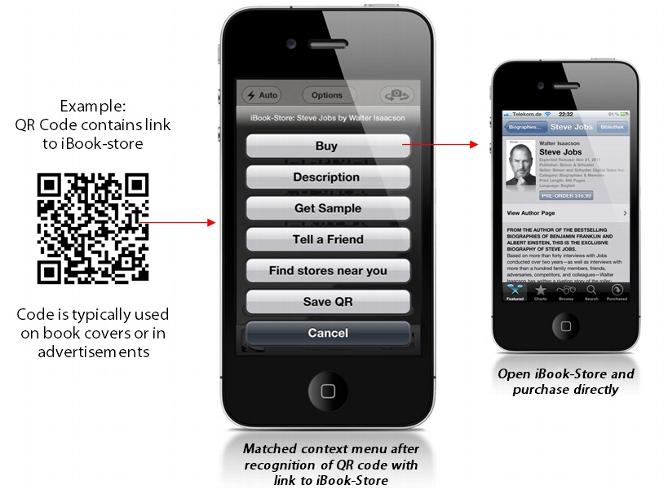
Having recognized an app store link in the QR code, the context-sensitive menu offers direct possibilities to ‘buy’ (from the iBooks store), more information about the book (‘description’) as well as the possibility to download an extract (‘get sample’) and (optionally) the function to find a nearby store. Furthermore, the user can recommend it via ‘tweet’ or email (‘tell a friend’).
In addition, QR codes can be saved (‘save QR’) as photo including decoded information and geographic coordinates of the shot (for later re-usage from the photo library).
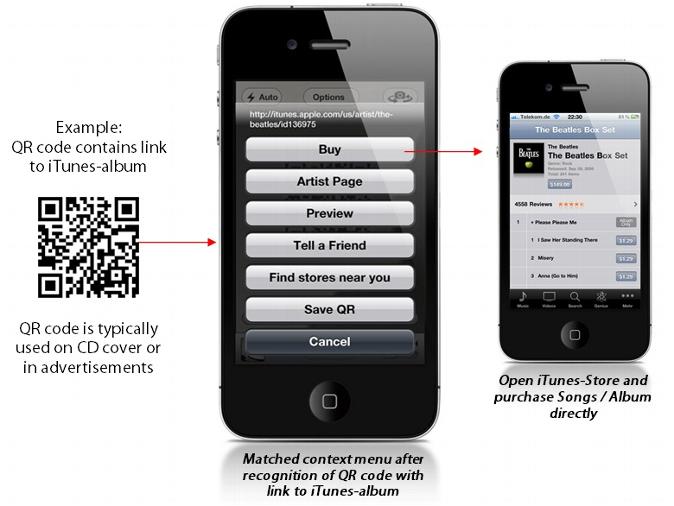
Having recognized an iTunes link in the QR code, the context-sensitive menu offers the direct possibility to ‘buy’ (from the iTunes store), further product information such as ‘artist page’ or ‘audio sample’ as well as (optionally) the function to find a nearby store. Furthermore, the user can recommend it via ‘tweet’ or email (‘tell a friend’).
In addition, QR codes can be saved (‘save QR’) as a photo including decoded information and geographic coordinates of the shot (for later re-usage from the photo library).
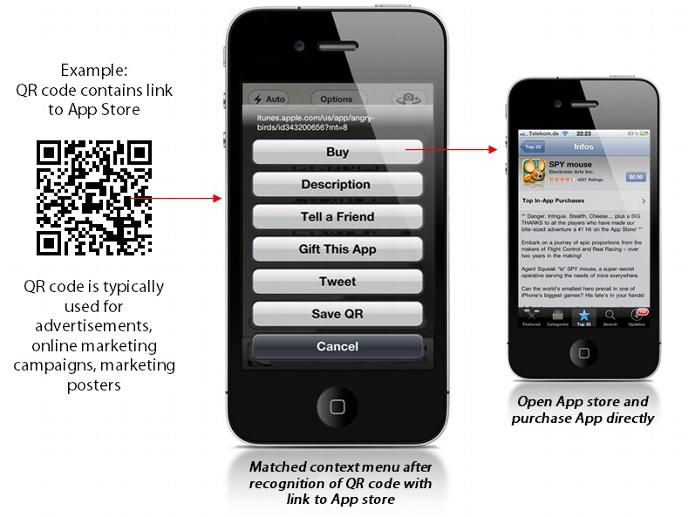
After an App store link has been detected in the QR code, the context-sensitive menu offers direct possibilities for purchase from the App store (‘buy’), calling up the app's description (‘description’) as well as the option to give away the app as a present (‘gift this app’). Furthermore, the user can recommend it via ‘tweet’ or email (‘tell a friend’).
In addition, the QR code can be saved (‘save QR’) as photo including decoded information and geographic coordinates of the shot (for later re-usage from the photo library).
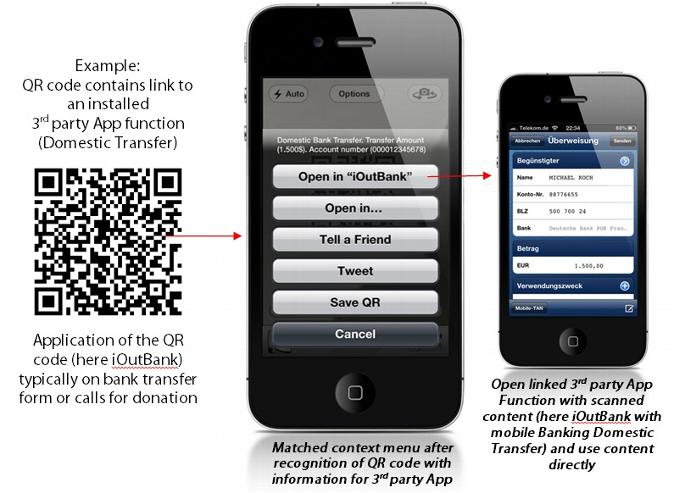
Having recognized an app call in the QR code, the context-sensitive menu enables either the information to be used directly (e. g. bank transfer), in a referenced app (e. g. iOutBank), or the selection of additional adequate applications (e. g. map coordinates in Google Maps or Navigon). Furthermore, the app can be recommended via ‘tweet’ or email (‘tell a friend’).
In addition, the QR codes are saved (‘save QR’) as a photo including decoded information and geographic coordinates of the shot (for later re-usage from the photo library).
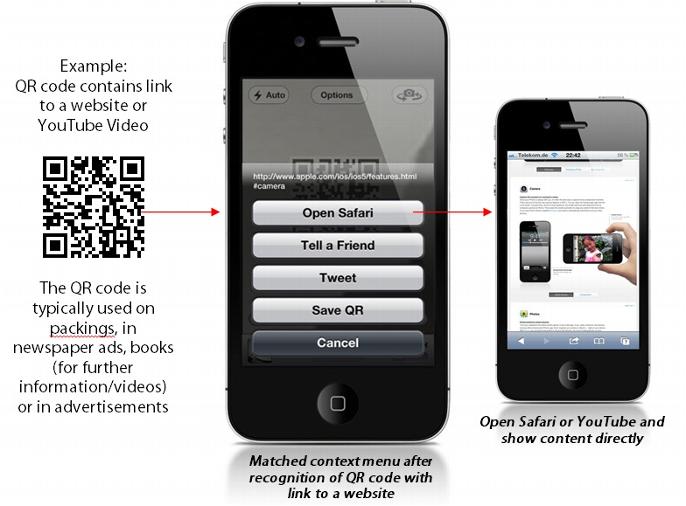
Having recognized a standard link in the QR code, the context-sensitive menu enables the website to be ‘opened’ directly in Safari (‘Open Safari’). Furthermore, the user can recommend it via ‘tweet’ or email (‘tell a friend’).
In addition, the QR codes can be saved (‘save QR’) as photo including decoded information and geographic coordinates of the shot (for later re-usage from the photo library).
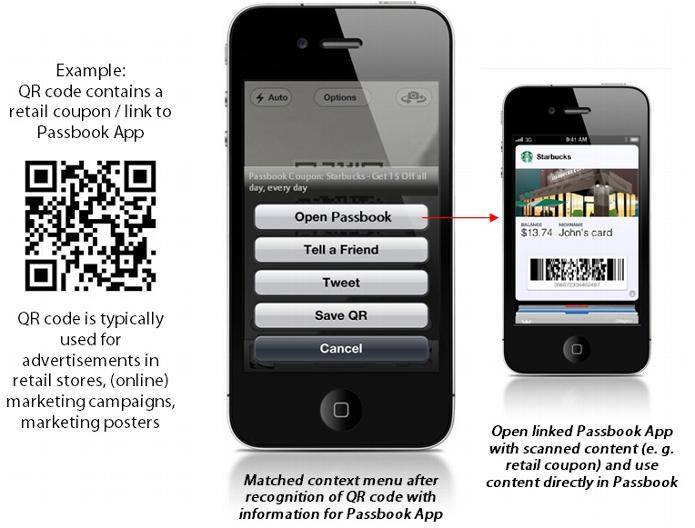
Having recognized a Passbook link in the QR code, the context-sensitive menu shows a short preview and offers direct possibilities to use the information for the Passbook App (‘Open Passbook’). Furthermore, the user can recommend it via ‘tweet’ or email (‘tell a friend’).
In addition, the QR code can be saved (‘save QR’) as photo including decoded information and geographic coordinates of the shot (for later re-usage from the photo library)
4.7 Further Ideas and possible application
Additional examples of uses for QR codes and their integrated processing:
- iAd link to product advertisements or advertising campaigns; where a direct and more detailed iAd presentation is called up immediately.
- “Ask Siri” QR Code to do all the things Siri can do without using your voice. ;-)
- Order information (Amazon app link) -> calls up Amazon app or Safari to buy the product directly.
- „iLike“ QR Code with direct call of Facebook-App in order to increase customer relations in advertisement campaigns.
- Email QR Code for newsletter registration or participation in competitions; email clients are called up directly.
- Routing data -> calls up navigation app or Google Maps with target coordinates to the nearest store, e. g. on advertisement posters
- Menu or coffee cup with direct link to the individual store’s order app.
- Usage of previously scanned and stored QR codes (photo library) for reuse in the store (‘Couponing’).
- Usage of previously scanned and stored or purchased QR codes as admission tickets.
- Further information in books and newspapers, e. g. direct retrieval and display of Wikipedia articles or YouTube videos as a real multimedia customer experience.
- Adaption or introduction of customized QR-Apple tags (optically and in content), e. g. usage of bug-tolerant QR codes to integrate the Apple logo as well as definite customized Apple tags / QR code calls.
- Introduction/usage of a QR payment code as new mobile payment method integrated into the iTunes account.
Future prospects (further intelligent integrated camera functions)
In combination with a GPS signal, a compass, a gyro sensor, a powerful processor as well as a permanent internet connection, the iPhone camera offers an even wider range of use. Apart from the aforementioned QR code integration which can be used intuitively, this integrated solution would also be applicable to future augmented reality applications, e. g. direct overlay of further information within the camera display.The information and possible actions derived from the scanned QR code are directly displayed in the shoot mode via the recognized QR code (e. g. video, 3D animations or option menu) – without calling up any external application.
Further possible steps include the integration of object and face detection (as in iPhoto) and automated script recognition to identifying URLs or translations.
Challenges and solution
Avoid undesirable scan results or scam QR codes
To avoid undesirable scan results (gambling, porn, scam) all contents of QR codes must be transmitted to Apple and have to be analyzed before the context menu appears (just like “Siri” or “QuickMark”). Another benefit of this solution would imply further opportunities to control and optimize the outcome of every QR code scan. A further advantage would be the opportunity to check the effectiveness of QR-campaigns. However, I would vote against this solution (for the first roll out). The recognition time, barrier to use (due to privacy concerns in various countries) and complexity will increase. It would be like checking every e-mail links or safari URLs before opening. The potential risk in comparison to the added value of easy integration is negligible. But as Apple often offers the best and most secure solution this could be an option.
Stationary distribution
A QR code on all products (e.g. books, CDs, DVDs, other goods) for direct virtual connection poses a further challenge for physical distribution. The danger consists in the fact that the customer – after consultation – will purchase the product online, bypassing the local dealer. A solution might be ‘local QR codes‘ of the individual dealer which are thought to refer the buyer to the dealer’s app or are involved in the direct deal in the Apple store by means of a corresponding promo code (in the link). Furthermore, each time a QR code is scanned, the dealer conversely gains client contacts by the optional presentation of all adequate stores in the surroundings.
Googles Goggles
The first step towards integration as described in the concept has already been made on the Android platform by the integration of Goggles (1.6) in the Android camera as an additional integrated function. The problem of this solution is that all user images are centrally transferred to and evaluated by Google (data protection, privacy, transfer costs, upload times) whereas QR codes are locally evaluated and interpreted in milliseconds. In addition, QR codes (in comparison to general photo interpretation) are highly standardized and show an extremely high detection rate. Furthermore (due to their appearance and high recognition value), it is precisely QR codes that create a concrete reason for use in contrast to the standard photo recognition. Apple could again convert technological progress into intuitive customer experiences with economic value added.
Business Case
So why should Apple implement an intelligent QR Code reader to iOS, if there are already plenty of QR Apps with which Apple earns a considerable amount through sales and downloads? There are three reasons for that. Firstly, these earnings will continue to be (an upgraded iOS Cam App does not replace all other cool Cam Apps); secondly, the sales-push effect through the implementation, crosslinking, and the direct sale of digital goods will extremely increase; thirdly, Apple generates new customer experiences and thereby promotes customer loyalty towards the product and further increases the distribution of digital goods.
Management Summary
Easy,
fast, and integrated.
An intelligent QR code scanner integrated in
the iPhone camera.
Just unlock, point, and sell (more).
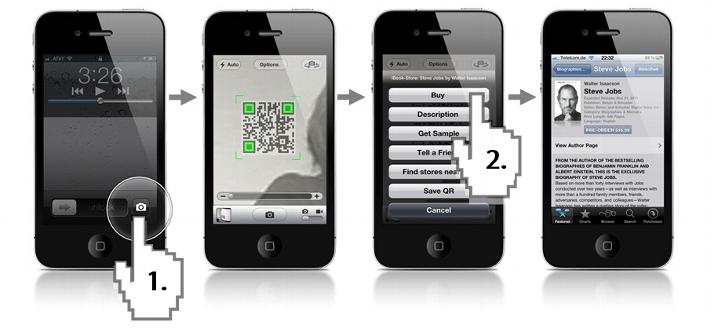
Direct access to the iPhone camera since the launch of iOS 5 paired with a new intelligently integrated QR code scanner within the camera application has finally brought the long-awaited breakthrough in user-friendliness by combining the physical and the virtual world with the related business models.
Just unlock, point, and sell (more).

(C) Michael Koch, Frankfurt (Germany), Concept written from September 2011 - August 2012 - Apple Feature Request from 28-Sep-2011 04:22 PM - https://bugreport.apple.com/cgi-bin/WebObjects/RadarWeb.woa/36/wo/aq5UNbRquu4QD4yKqb0AFg/5.83.28.0.9
The
author

Since 1998, Michael Koch has been responsible for the continuous further development of online and mobile banking for one of the largest German Banks. In this role, his duties include the extension of the customer transaction platform to a high-quality online distribution platform, the establishment and expansion of new online banking security standards as well as development of a multichannel strategy and the evolution of the mobile channel to an integral networking of all access roads (online, phone, branch) of the bank. Furthermore, he has also developed innovative features for the mobile Banking Apps and as an enthusiastic Smartphone user, Koch is convinced that the integrated use of all Smartphone components offers many more revolutionary possibilities.
Contact:
name / location
Michael Koch, Frankfurt (Germany)
email
koch@online.de
profile
http://de.linkedin.com/pub/michael-koch/33/a18/436
https://www.xing.com/profile/Michael_Koch98
Apple Feature Request
https://bugreport.apple.com/cgi-bin/WebObjects/RadarWeb.woa/36/wo/aq5UNbRquu4QD4yKqb0AFg/5.83.28.0.9
(Originated Date: 28-Sep-2011 04:22 PM)
List of references
*1 iPhone 4 Becoming Most Popular Camera on Flickr http://www.flickr.com/cameras/
*2 The QR Invasion http://mashable.com/2011/03/04/qr-codes-infographic/
*3 14 Million Americans Scanned QR Codes on their Mobile Phones in June 2011http://www.npr.org/2011/09/26/140805493/few-consumers-are-cracking-the-qr-code
*4 Survey: 83 Percent Of Young Shoppers Can’t Handle QR Codes http://storefrontbacktalk.com/e-commerce/survey-83-percent-of-young-shoppers-cant-handle-qr-codes/
Backup (see PDF Download)
-->>> Download Full Concept as PDF
Tweet
Last Update: 09 - 04 - 2012
Many Thanks to Beate & Anne for the support for the translation.
Many Thanks to Matthias, Andreas & Henrik for the inspiring discussions and the great "iphone & beer"-events ;)